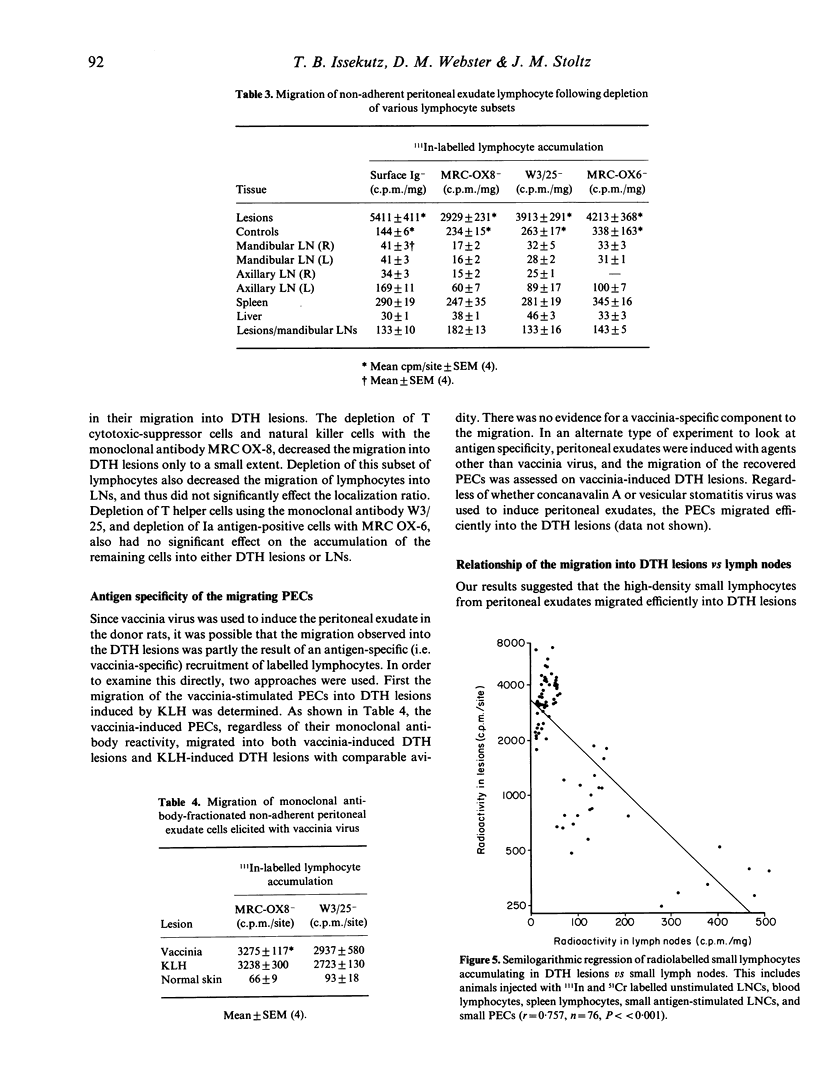Abstract
Our goal was to study the small lymphocytes that were recruited to cutaneous DTH lesions in order to determine if there existed a subset of small lymphocytes which preferentially migrated into cutaneous inflammatory sites rather than into lymphoid tissues. Lymphocytes were radiolabelled and injected i.v. into sensitized recipient rats on which DTH lesions were induced by the i.d. injection of vaccinia virus. Small lymphocytes, from unstimulated and antigen-stimulated LNs, migrated in large numbers to LNs but only to a modest extent to the DTH lesions. Lymphoblasts, from antigen-stimulated nodes, migrated to DTH lesions well, but poorly to normal LNs. The ratio of the radioactivity in the lesions to that in LNs was used as an index of the preferential migration of the cells. This ratio for small lymphocytes was 0.8:1, while that of lymphoblasts was 34:1. Lymphocytes from the blood and spleen were better at entering lesions than the small LNCs, and their ratio was higher. Peritoneal exudate lymphocytes induced by the i.p. injection of virus migrated very well to the DTH lesions and poorly into LNs, and produced a ratio of 130:1. The peritoneal lymphocytes that migrated into the lesions were primarily small lymphocytes. Negative selection for either surface Ig-, W3/25-, MRC OX-8- or MRC OX-6- cells had little effect on the accumulation of the cells within the DTH lesions. In conclusion, it is suggested that there exists a subset of small lymphocytes with receptors on their surfaces which cause them to migrate selectively to inflammatory sites rather than to LNs. An inflammatory exudate is a rich source of this subset of small lymphocytes, while only a small proportion of small LNCs being to this subset.
Full text
PDF







Selected References
These references are in PubMed. This may not be the complete list of references from this article.
- Asherson G. L., Allwood G. G. Inflammatory lymphoid cells. Cells in immunized lymph nodes that move to sites of inflammation. Immunology. 1972 Mar;22(3):493–502. [PMC free article] [PubMed] [Google Scholar]
- Cahill R. N., Poskitt D. C., Frost D. C., Trnka Z. Two distinct pools of recirculating T lymphocytes: migratory characteristics of nodal and intestinal T lymphocytes. J Exp Med. 1977 Feb 1;145(2):420–428. doi: 10.1084/jem.145.2.420. [DOI] [PMC free article] [PubMed] [Google Scholar]
- Chin W., Hay J. B. A comparison of lymphocyte migration through intestinal lymph nodes, subcutaneous lymph nodes, and chronic inflammatory sites of sheep. Gastroenterology. 1980 Dec;79(6):1231–1242. [PubMed] [Google Scholar]
- Chin Y. H., Carey G. D., Woodruff J. J. Lymphocyte recognition of lymph node high endothelium. IV. Cell surface structures mediating entry into lymph nodes. J Immunol. 1982 Nov;129(5):1911–1915. [PubMed] [Google Scholar]
- Chin Y. H., Rasmussen R., Cakiroglu A. G., Woodruff J. J. Lymphocyte recognition of lymph node high endothelium. VI. Evidence of distinct structures mediating binding to high endothelial cells of lymph nodes and Peyer's patches. J Immunol. 1984 Dec;133(6):2961–2965. [PubMed] [Google Scholar]
- Duarte A. J., Carpenter C. B., Strom T. B. Expression of T cell differentiation antigens and Ia on rat cytotoxic T lymphocytes. J Immunol. 1982 Feb;128(2):580–584. [PubMed] [Google Scholar]
- Issekutz T. B., Chin G. W., Hay J. B. Lymphocyte traffic through chronic inflammatory lesions: differential migration versus differential retention. Clin Exp Immunol. 1981 Sep;45(3):604–614. [PMC free article] [PubMed] [Google Scholar]
- Issekutz T. B., Chin W., Hay J. B. Lymphocyte traffic through granulomas: differences in the recovery of indium-111-labeled lymphocytes in afferent and efferent lymph. Cell Immunol. 1980 Aug 15;54(1):79–86. doi: 10.1016/0008-8749(80)90191-4. [DOI] [PubMed] [Google Scholar]
- MCCLUSKEY R. T., BENACERRAF B., MCCLUSKEY J. W. STUDIES ON THE SPECIFICITY OF THE CELLULAR INFILTRATE IN DELAYED HYPERSENSITIVITY REACTIONS. J Immunol. 1963 Mar;90:466–477. [PubMed] [Google Scholar]
- Ottaway C. A., Parrott D. M. Regional blood flow and its relationship to lymphocyte and lymphoblast traffic during a primary immune reaction. J Exp Med. 1979 Aug 1;150(2):218–230. doi: 10.1084/jem.150.2.218. [DOI] [PMC free article] [PubMed] [Google Scholar]
- Platt J. L., Grant B. W., Eddy A. A., Michael A. F. Immune cell populations in cutaneous delayed-type hypersensitivity. J Exp Med. 1983 Oct 1;158(4):1227–1242. doi: 10.1084/jem.158.4.1227. [DOI] [PMC free article] [PubMed] [Google Scholar]
- Ranne G. H., Smith M. E., Ford W. L. Lymphocyte migration into cell-mediated immune lesions is inhibited by trypsin. Nature. 1977 Jun 9;267(5611):520–522. doi: 10.1038/267520a0. [DOI] [PubMed] [Google Scholar]
- Rose M. L., Parrott D. M., Bruce R. G. Migration of lymphoblasts to the small intestine. II. Divergent migration of mesenteric and peripheral immunoblasts to sites of inflammation in the mouse. Cell Immunol. 1976 Nov;27(1):36–46. doi: 10.1016/0008-8749(76)90151-9. [DOI] [PubMed] [Google Scholar]
- Rose M. L., Parrott D. M., Bruce R. G. The accumulation of immunoblasts in extravascular tissues including mammary gland, peritoneal cavity, gut and skin. Immunology. 1978 Aug;35(2):415–423. [PMC free article] [PubMed] [Google Scholar]
- Sabbadini E., Neri A., Sehon A. H. Localization of non-immune radioactively labelled cells in the lesions of contact sensitivity in mice. J Immunol Methods. 1974 May;5(1):9–19. doi: 10.1016/0022-1759(74)90041-6. [DOI] [PubMed] [Google Scholar]


